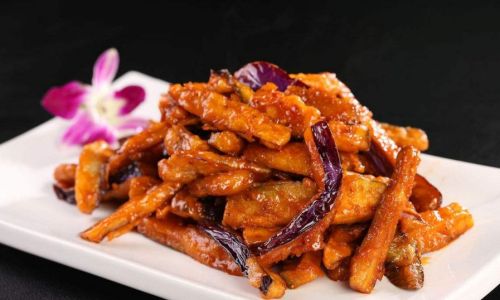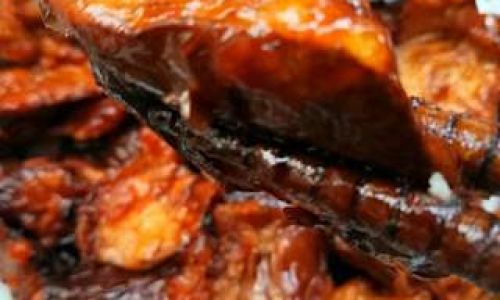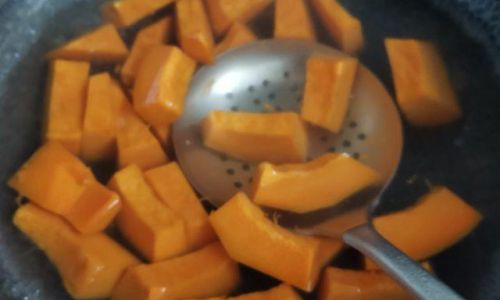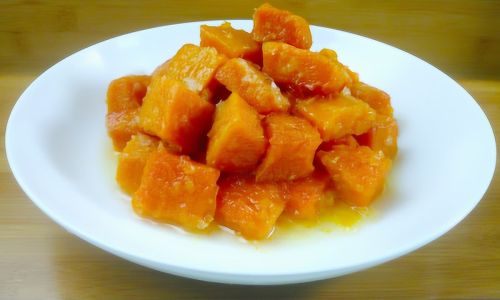Table of content
- Ingredients
- Tools
- Step 1: Slicing and Salting
- Step 2: Drying and Pressing
- Option 1: Classic Batter
- Option 2: Dry Coating
- Option 3: Panko Crust
- Step 1: Heating the Oil
- Step 2: Frying Technique
- Dipping Sauces
- Culinary Applications
- Problem 1: Soggy Coating
- Problem 2: Uneven Browning
- Problem 3: Greasy Taste
- Baking as a Healthier Alternative
- Gluten-Free Options
- Spicy Kick
- The Maillard Reaction
- Cornstarch vs. Flour
Introduction
Crispy eggplant, with its golden-brown exterior and tender, creamy interior, is a culinary delight that transcends borders and cultures. Whether served as a standalone appetizer, a side dish, or a star ingredient in global recipes like melanzane alla parmigiana (Italian) or yuxiang qiezi (Chinese), achieving that coveted crunch requires precision, patience, and a deep understanding of the vegetable’s unique properties. This article delves into the science and craft of frying eggplant to perfection, exploring techniques, ingredients, and troubleshooting tips to ensure your dish becomes a餐桌上的明星 (table-top sensation).

Chapter 1: Understanding the Eggplant’s Anatomy
Eggplants (Solanum melongena), also known as aubergines, belong to the nightshade family. Their spongy flesh and high water content (up to 92%) make them prone to absorbing oil during frying, which can lead to greasy, soggy results if not handled correctly. The key to crispiness lies in managing moisture and creating a protective barrier that seals in flavor while repelling excess oil.
Varieties Matter
Not all eggplants are created equal. For frying, opt for firm, glossy varieties with fewer seeds, such as:
- Japanese eggplant: Long, slender, and mildly sweet.
- Italian eggplant: Plump and versatile.
- Chinese eggplant: Delicate with thin skin.
Avoid overripe specimens, which may have bitter undertones and softer flesh.
Chapter 2: Essential Ingredients and Tools
To elevate your frying game, gather the following:

Ingredients
- Eggplants: 2–3 medium-sized (depending on the recipe).
- Salt: Kosher or sea salt for drawing out moisture.
- Cornstarch: Creates a light, airy crust.
- All-purpose flour: Adds structure to the batter.
- Spices: Paprika, garlic powder, or black pepper (optional).
- Frying oil: Neutral oils like peanut, canola, or sunflower (high smoke point).
- Water or sparkling water: For batter consistency.
Tools
- Sharp knife: For uniform slicing.
- Colander: For draining moisture.
- Thermometer: To monitor oil temperature (350–375°F/175–190°C).
- Slotted spoon: For gentle flipping.
- Wire rack: Prevents sogginess post-frying.
Chapter 3: Preparation: The Foundation of Crispiness
Step 1: Slicing and Salting
- Wash and trim the eggplant, removing the stem.
- Slice uniformly: Cut into ½-inch rounds, batons, or wedges. Consistency ensures even cooking.
- Salt liberally: Layer slices in a colander, sprinkling salt between each layer. Let sit for 30–45 minutes.
- Why salt? Salt breaks down cell walls, expelling excess moisture and bitterness. This step also firms the flesh, reducing oil absorption.
Step 2: Drying and Pressing
- Rinse thoroughly under cold water to remove salt.
- Pat dry with paper towels or a clean kitchen cloth.
- Optional: Place slices between layers of paper towels and press gently to extract residual moisture.
Chapter 4: The Batter or Coating: Your Armor Against Sogginess
Option 1: Classic Batter
- Mix: ½ cup cornstarch, ½ cup all-purpose flour, 1 tsp salt, 1 tsp paprika, and 1 cup ice-cold water.
- Whisk until smooth. The cold water prevents gluten development, ensuring a delicate crunch.
Option 2: Dry Coating
- Combine: 1 cup cornstarch, 1 tsp garlic powder, 1 tsp black pepper.
- Dredge eggplant slices in the mixture, shaking off excess.
Option 3: Panko Crust
- Double-coat: Dip in batter, then press into panko breadcrumbs for extra texture.
Chapter 5: Frying Mastery
Step 1: Heating the Oil
- Use a heavy-bottomed pan (cast iron or stainless steel) for even heat distribution.
- Fill with 2–3 inches of oil. Avoid overcrowding, which lowers oil temperature.
- Heat to 350–375°F (175–190°C). Use a thermometer for accuracy.
Step 2: Frying Technique
- Test the oil with a small piece of eggplant—it should sizzle vigorously but not smoke.
- Fry in batches: 4–5 slices at a time. Overcrowding causes temperature drops and steaming.
- Fry for 3–4 minutes per side, or until golden-brown.
- Drain on a wire rack (not paper towels, which trap steam).
Chapter 6: Serving Suggestions and Pairings
Dipping Sauces
- Sweet chili sauce: Mix honey, rice vinegar, and red pepper flakes.
- Tahini yogurt: Whisk tahini, Greek yogurt, lemon juice, and garlic.
- Soy-ginger glaze: Soy sauce, mirin, grated ginger, and brown sugar.
Culinary Applications
- Eggplant Parmesan: Layer fried slices with marinara and mozzarella.
- Stir-fries: Toss into garlic-soy sauce with vegetables.
- Salads: Top with pomegranate seeds and feta for a Mediterranean twist.
Chapter 7: Troubleshooting Common Pitfalls
Problem 1: Soggy Coating
- Cause: Low oil temperature or excess moisture.
- Fix: Ensure oil is hot enough and pat eggplant dry before coating.
Problem 2: Uneven Browning
- Cause: Inconsistent slice thickness or overcrowding.
- Fix: Use a mandoline for even slices and fry in small batches.
Problem 3: Greasy Taste
- Cause: Frying at too low a temperature or using old oil.
- Fix: Maintain oil temperature and strain/replace oil after 3–4 uses.
Chapter 8: Advanced Techniques and Variations
Baking as a Healthier Alternative
- Preheat oven to 425°F (220°C).
- Coat eggplant in a mix of panko, Parmesan, and herbs.
- Bake for 20–25 minutes, flipping halfway.
Gluten-Free Options
- Substitute all-purpose flour with rice flour or chickpea flour.
- Use almond meal for a nutty crust.
Spicy Kick
- Add cayenne pepper or chili flakes to the batter.
- Serve with a sriracha-mayo dip.
Chapter 9: The Science Behind Crispiness
The Maillard Reaction
At 310°F (154°C), amino acids and sugars on the eggplant’s surface react, creating brown pigments and complex flavors. Achieving this requires precise oil temperature control.
Cornstarch vs. Flour
- Cornstarch: Contains less gluten, resulting in a lighter, crispier crust.
- Flour: Adds structure but can become dense if overmixed.
Chapter 10: Cultural Significance and History
Eggplant cultivation dates back over 2,000 years to ancient China and India. In Mediterranean cuisine, fried eggplant became a staple during the Ottoman Empire, while Japanese nasu dengaku (miso-glazed eggplant) showcases its versatility. Today, crispy eggplant bridges traditions, appearing in fusion dishes like eggplant fries with aioli or vegan “chicken” tenders.
Conclusion: Elevate Your Eggplant Game
Mastering crispy eggplant is a journey of trial and error, but with the right techniques, you can transform this humble vegetable into a restaurant-worthy dish. Remember: patience in preparation, precision in frying, and creativity in seasoning are your greatest allies. Whether you’re a home cook or an aspiring chef, the satisfaction of a perfectly crunchy bite will always be worth the effort.

Final Tip: Experiment with herbs like basil or mint, or pair with unexpected flavors like honey or balsamic reduction. The possibilities are as endless as the eggplant’s culinary history. Now, grab your apron, heat that oil, and let the sizzling begin!





0 comments